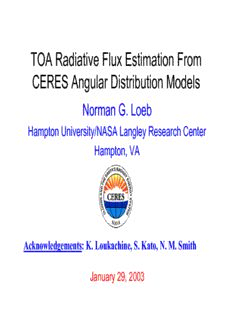
CERES Angular Dependence Models for Radiance to Flux Conversion PDF
Preview CERES Angular Dependence Models for Radiance to Flux Conversion
TOA Radiative Flux Estimation From CERES Angular Distribution Models Norman G. Loeb Hampton University/NASA Langley Research Center Hampton, VA Acknowledgements: K. Loukachine, S. Kato, N. M. Smith January 29, 2003 Outline 1. Introduction 2. TOA flux retrieval strategy – ADM definition 3. CERES/TRMM Validation Results 4. Plans for CERES/Terra ADMs 5. Summary Top-of-Atmosphere Radiation Budget (Incoming Solar = Outgoing Longwave): S − o = σ 4 ≈ + (1 A) T 208 2T e s 4 = A Planetary Albedo = S Solar Irradiance o = T Earth Radiative Temperature e = T Equilibrium Surface Temperature s F I F I ∆ 1 S A ο ∆ = − H o K ∆ ≈ − H K T A 0.5 C 100 s 2 4 A 1% relative error in A ≈ ≈ ° ⇒ 1 W m-2 flux error ⇒ 0.5 C error in T s 2xCO => +4 W m-2 2 Instantaneous Fluxes at TOA and Angular Distribution Models CERES Radiance Measurement TOA Flux Estimate SW LW WN ⇒ Satellite Sun • θ θ o φ Instantaneous Fluxes at TOA and Angular Distribution Models TOA flux estimate from CERES radiance: where, θ θ φ R ( , , ) is the Angular Distribution Model (ADM) for the “jth” scene type. j o ADM Scene Identification • The main reason for defining ADMs by scene type is to reduce the error in the albedo estimate. => Earth scenes have distinct anisotropic characteristics which depend on their physical and optical properties. (e.g. thin vs thick clouds; cloud-free, broken, overcast etc.). => Scene identification must be self-consistent. Biases in cloud property retrievals (e.g. due to 3D cloud effects) should not introduce biases in flux/albedo estimates. CERES/TRMM Overcast Ice Cloud ADMs vs ERBE θ ( =53.1-60) o Overcast LW ADMs (Precipitable Water 4.63 – 10.00 cm) Anisotropic Model Scene Type Stratification Spacecraft/Mission Cloud Surface Type Total TIROS 2, 3, 4 N/A N/A isotropy TIROS 7 Global Global 1 (Arking and Levine, 1967) Nimbus 2, 3 Cloud/Land Ocean 3 (Rashke et al. 1973) Snow Ocean All Cloud Nimbus-6, 7 4 Land (Taylor and Stowe, 1984; Snow/Ice Jacobowitz et al., 1984) Ocean ERBE Clear Land 12 (Smith et al., 1986; Partly cloudy Desert Suttles et al., 1988) Mostly cloudy Snow Overcast Land-Ocean Mix
Description: